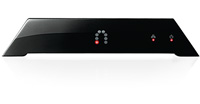Author: Joe Moran
Review Date: 12/20/2006

Taking the time to relax and watch a favorite TV show is one of life’s simple pleasures. But if you travel frequently, it may be a pleasure often denied (or at least delayed). If you regularly miss shows you want to watch because your away from home, you’ll want to take a close look at Sling Media’s Slingbox, a small device that connects to your home network and lets you watch your TV shows from just about anywhere.
There are three different Slingbox devices to choose from — the Slingbox Tuner, for those with basic analog cable (no set-top box), the Slingbox AV, which works with a cable/satellite receiver or DVR, and the Slingbox Pro, which supports multiple devices and component video connections (with an add-on dongle). We looked at the $179.99 (MSRP) Slingbox AV and think it’s a great product — it’s easy to set up and even easier to use, and offers video quality ranging from OK to excellent.
What’s That Term? Not sure what a particular term means? Check out the searchable PracticallyNetworked Glossary. |
Physical Setup
The first order of business is to make the physical connections between the Slingbox and your cable box, satellite receiver or digital video recorder. The Slingbox AV lets you do this via with a choice of composite and S-Video input plus a pair of RCA-style left/right audio jacks. One of the things to be aware of with the AV model in particular is that in order connect it to a video source, the source must offer two sets of outputs for both audio and video. In other words, if a device’s only set of outputs is being used to connect it to a television, you’ll be out of luck.
We ran into this issue when we tried to pair the Slingbox AV to a Toshiba TiVo Series 2 DVR with an integrated DVD Recorder. Although the Toshiba had multiple video outputs to choose from (composite, S-Video, component) it’ sole pair of RCA jacks were the only way get audio into the Slingbox, and they were already connected to the television. (The same was true of a Scientific Atlanta Explorer 3200 digital cable box — only one set of outputs, and they were going into the TiVo.) Fortunately, we also had a standard TiVo Series 2 box with a set of free outputs that would accommodate the Slingbox. (The Slingbox Tuner and Pro models avoid this problem by providing both input and output connectors, allowing for signal pass-through.)
In addition to making the video and audio connections, you also need to connect the Slingbox’s to your network via its RJ-45 LAN port. Since the Slingbox doesn’t have built-in Wi-Fi, you can add it to your network using a Wi-Fi bridge (as we did) or opt for a HomePlug adapter or similar AC powerline technology (that’s assuming that like most homes, yours isn’t wired for Ethernet).
Last but not least, in order for the Slingbox to control your device you must connect an IR cable and align it with the receive window on your device. (All of the necessary AV, network, and IR cables are included with the Slingbox.)
Software Installation and Device Configuration
To access your Slingbox via the network you need the SlingPlayer client software, which is available for Windows Vista/XP/2000 as well as for Pocket PC and Windows Mobile Smartphone devices. (There’s also a version for Mac OS X 10.3 or better currently in beta, and versions for Palm and Symbian Series 60 mobile devices are also in the works.)
Installing and configuring the SlingPlayer software was simple — when we installed it on a Windows XP system, our Slingbox was promptly detected and its firmware updated. You can then choose the make and model of AV device you’re using (from a list provided) so that the correct IR control codes can be selected and tested — we were able to successfully control the TiVo on the first try. There’s also the option (highly recommended) to set up two passwords for Slingbox access — a login password for viewing rights, and an administrator password that enables you to change device settings.
The SlingPlayer includes a built-in Video Tuning Wizard to optimize image quality. It’s basically like the test you take at the optometrist — you’re presented with a series of identical video clips (presented side-by-side) and asked to specify which one looks best. The test clips also include text, which help make sure things like program guides, menus, and news/stock crawls are readable.
The final step is to configure your router so you can access the Slingbox while you’re away from home. If you’re using a UPnP-compatible router (a list of Slingbox-recommended routers can be found here), the Slingbox can automatically configure it to permit outside access without the need to explicitly forward TCP/IP ports — this auto-configure process worked like a charm with our Netgear WPN824, but if your router doesn’t support configuration via UPnP you have to create an explicit firewall rule to forward traffic on port 5001 to the Slingbox’s IP address.
The best way to access a Slingbox for remote viewing is through the (free) Slingbox Finder service, which maintains a directory of Slingbox devices and allows you to find yours using a unique 32-digit “Finder ID.” The nice thing about using Slingbox Finder to access your Slingbox is that it eliminates the need to know your home network’s IP address. You can also reach your Slingbox by specifying its IP address and port number, but then you must have a static IP address or use a dynamic DNS service to ensure that your Slingbox is reachable even if your network’s IP address changes.
Local and Remote Viewing
When using the SlingPlayer client on our local network (to access both live and recorded programming), we found the quality to be excellent and, in fact, every bit as good as the original signal.
To provide the best video and audio quality possible, Sling’s proprietary SlingStream codec continually optimizes the stream based on factors like network conditions and the type of device you’re viewing from. (From inside the home network, the SlingPlayer reported streaming performance of approximately 3 Mb/sec.)
Accessing the Slingbox from home can certainly be handy, but most people will want to watch video while away from home. The company recommends having at least 250 Mb/sec of upstream when logging in from outside your home network (our Comcast cable modem connection provided about 360 Mb/sec).
To see how the Slingbox would fare in this situation, we accessed it from location across town. We had no difficulty locating and logging into the Slingbox using its Finder ID, and this time the first eight to ten seconds of the Slingbox’s stream was halting and choppy. After that, however, it settled down nicely and proceeded to provide smooth and consistent playback. The video image was somewhat fuzzier and less crisp than it had been on the home network. Nevertheless it was still quite good and very watchable, and certainly impressive given that the SlingPlayer reported streaming only around 320 kb/sec — roughly a tenth of the data it had on the home network.
To gage performance with some real distance between the Slingbox and the viewer, we asked a colleague to log in and watch it from nearly 1,500 miles away. Although the streaming rate was similar (about 300 kb/sec) the video quality was significantly more pixelated and would more aptly be described as adequate than good. This is probably the result of increased latency caused by the added distance. As a general rule, it stands to reason that the closer you are geographically to your Slingbox, the better your quality is likely to be.
No matter where you’re watching from, the SlingPlayer video window can be resized as needed and docked to the edges of your screen, and a separate window includes a graphical representation of your device’s remote control that looks and works just like the real thing (it even plays the trademark TiVo sound effects). When viewing remotely, the remote’s responsiveness can be lackadaisical at times. When this happens you can enable the SlingPlayer’s control mode, which reduces the lag time by lowering the video frame rate. (When you’re done using the remote you can exit control mode, and the video returns to normal.)
The Bottom Line
The advent of the DVR revolutionized television by letting you effortlessly “time shift” the shows you wanted to watch. Especially when paired with a DVR, the “place shifting” capabilities of the Slingbox AV are almost as profound. The Slingbox can put an end to missed shows or the need to park yourself in front of the TiVo for a marathon session upon returning home, and it also offers a way to watch a TV from another room in your home when the actual television is being used for another purpose (say, a DVD or videogame).
All in all, if TV is important to you, then you’ll want to put the Slingbox on your shopping list.
Price: $179.99 (MSRP)
Pros: simple hardware and software configuration; good video/audio quality under most conditions; Slingbox Finder service lets you access device remotely without knowing IP address
Cons: Lacks built-in WiFi; doesn’t support pass-through connections, so you must have unused outputs on your cable/satellite box or DVR.
Joe Moran is a regular contributor to PracticallyNetworked.



